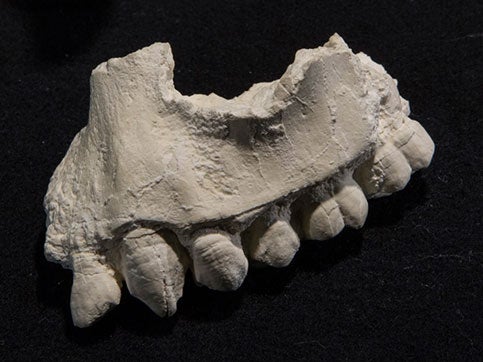Scientists unearth new species of human ancestor in Ethiopia
The bones and teeth of Australopithecus deyiremeda are more than 3 million years old

A new hominin that existed around three million years ago and was related to the famous "Lucy" species has been discovered.
Researchers claim that they have unearthed the new species, called Australopithecus deyiremedal, in Ethiopia's Woranso-Mille area of the Afar region.
According to a study published in the journal Nature today, jaw bones and teeth which are thought to have belonged to four individuals with both ape and human-like features have been found, dating to between 3.3 million and 3.5 million years old.
“This new species has very robust jaws. In addition, we see this new species had smaller teeth. The canine is really small – smaller than all known hominins we have documented in the past,” Dr Yohannes Haile-Selassie, lead researcher of the study, told the BBC.
Some scientists have argued that only one human ancestor species existed between three and four million years ago. But the unearthing of Kenyanthropus platyops in Kenya and Australopithecus bahrelghazali in Chad, and now Ethiopia’s Australopithecus deyiremedal, mean that several early human species could have been alive at the same time as Lucy.
The paper said: “There is now incontrovertible evidence to show that multiple hominins existed contemporaneously in eastern Africa during the Middle Pliocene… What remains intriguing, and requires further investigation, is how these taxa are related to each other and to later hominins, and what environmental and ecological factors triggered such diversity.”
Dr Haile-Selassie said: “Historically, because we didn’t have the fossil evidence to show there was hominin diversity during the middle Pliocene, we thought there was only one lineage, one primitive ancestor – in this case Australopithecus afarensis, Lucy – giving rise to the next.”
He said that the hypothesis of linear evolution had to be revisited.
“What this means is we have many species that could give rise to later hominins, including our own genus homo,” he said.
However, paleoanthropologist Bill Kimbel, from the Institute of Human Origins, told the National Geographic that the distinctions between Australopithecus deyiremedal and Australopithecus afarensis are “very subtle”.
“I think the authors have done a very nice job in [analysing] the material, but I think it’s a judgment call as to whether you think the differences amount to a species-level difference,” said Kimbel.
Subscribe to Independent Premium to bookmark this article
Want to bookmark your favourite articles and stories to read or reference later? Start your Independent Premium subscription today.

Join our commenting forum
Join thought-provoking conversations, follow other Independent readers and see their replies